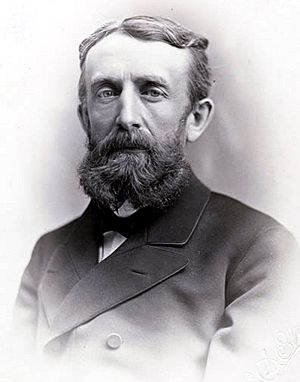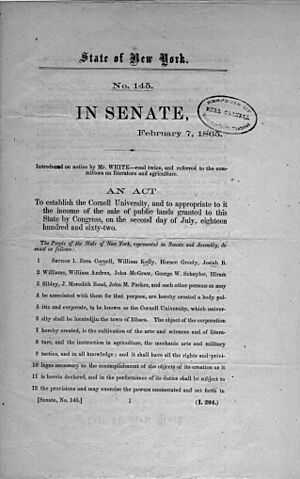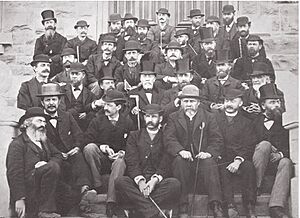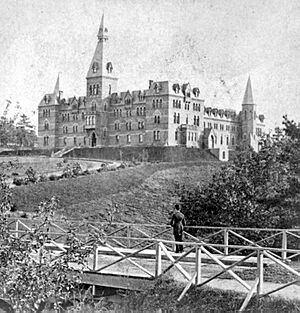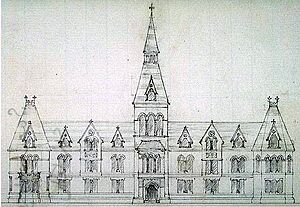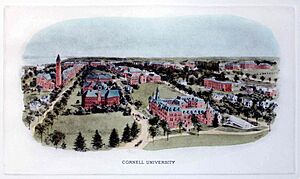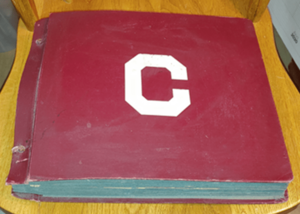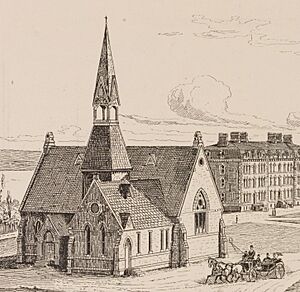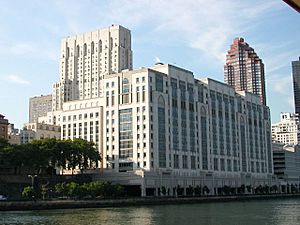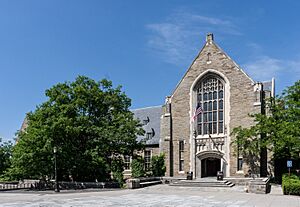History of Cornell University facts for kids
The history of Cornell University began when its two founders, Andrew Dickson White and Ezra Cornell, met in the New York State Senate in January 1864. Together, they started Cornell University in Ithaca, New York, in 1865. The university received its first money from Ezra Cornell's $400,000 gift and from New York's large land grant (about 989,920 acres) given by the Morrill Land-Grant Colleges Act of 1862.
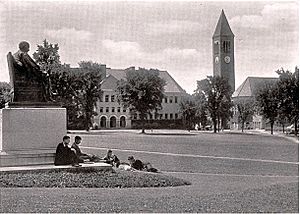
Even before they met, both Ezra Cornell and Andrew White had big dreams. White wanted to create a new kind of university for the nation. Cornell, who cared a lot about education and helping others, wanted to use his money "to do the greatest good." The Morrill Land Grant Act, signed by Abraham Lincoln, also helped many universities, including Cornell, start after the American Civil War.
Contents
- Early Ideas for a New University
- Meet the Founders: Ezra Cornell and Andrew White
- How Cornell University Was Conceived
- Establishing Cornell University
- Opening Day at Cornell
- Coeducation at Cornell
- Non-Religious Approach and Faith on Campus
- Cool Innovations at Cornell
- Support from New York State
- Medical Education at Cornell
- Cornell Aeronautical Laboratory
- Race Relations at Cornell
- How Cornell Helps Students Afford College
- Images for kids
Early Ideas for a New University
Long before Cornell University was founded, a man named Gerrit Smith had an idea for a great university in New York. Smith was an abolitionist, meaning he fought against slavery.
He helped start a college called New York Central College (1849–1860) in McGraw, New York. This college was special because it was the first in the United States to welcome women, Black people, and Native Americans equally from its very first day. It was also the first to hire Black teachers who taught classes with white students. Students at this college also worked for a few hours each day, which was part of a movement called "manual labor colleges."
Unfortunately, Central College faced financial problems and a lot of unfair treatment due to prejudice. Eventually, Gerrit Smith took over the college's debts and assets when it went bankrupt.
Meet the Founders: Ezra Cornell and Andrew White
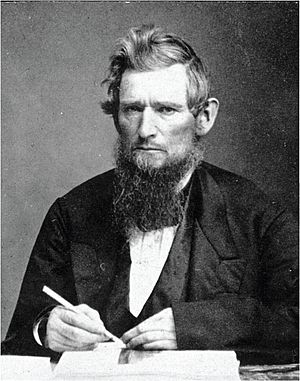
Ezra Cornell and Andrew White were both new members of the state senate. Cornell led the Committee of Agriculture, and White led the Committee of Literature, which handled education. Both committees were in charge of deciding how to use the land grant money for education in farming and practical skills.
Their partnership seemed unlikely at first because they came from very different backgrounds. Ezra Cornell was a self-made businessman who became rich from the Western Union Telegraph Company. He had been poor for most of his life and suddenly had a lot of money. He wanted to use it to help others, especially by supporting colleges that taught practical subjects like farming, engineering, and veterinary medicine. He also wanted to help poor people get an education.
Andrew Dickson White started college in 1849. He dreamed of attending a top eastern college but ended up at a smaller one first. There, he read about famous universities like Oxford and Cambridge, which inspired his dream of building a great university for New York and the nation. He later went to Yale University, which was better, but he still felt it lacked real discussions.
In the late 1850s, White taught history at the University of Michigan. He continued to develop his ideas for a great American university, influenced by Michigan's more open curriculum and its non-religious approach.
How Cornell University Was Conceived
White was impressed by Ezra Cornell's generosity when Cornell donated $100,000 to start a large public library in Ithaca. White admired Cornell's broad-mindedness, especially how he chose people for the library's board of trustees. Cornell picked the best people in town, including his political rivals and leaders from all major churches, showing he wasn't trying to control the organization with one group.
However, Cornell and White initially disagreed on how to use the state's land grant. In 1863, the state had given the money to People's College, but it seemed unlikely that college would meet the conditions. Cornell, who was on the board of another school, the New York State Agricultural College, wanted half the grant to go there. White strongly disagreed, believing the money would be more effective if used to create or strengthen one big university.
On September 25, 1864, Cornell offered to donate $300,000 (later increased to $500,000) if part of the land grant went to his college and it moved to Ithaca. White still didn't want to split the grant. But he said he would support a plan that kept the grant together for one comprehensive university. This led to their partnership, which eventually created Cornell University.
Establishing Cornell University
On February 7, 1865, Andrew White introduced a bill to the State Senate to create "the Cornell University." This bill gave all the money from the land grant to the new university. But Cornell and White faced strong opposition. Other colleges wanted a share of the money, religious groups disagreed with the university's proposed board, and some newspapers thought Cornell was tricking the state.
To get enough votes, the bill was changed twice. First, People's College was given three months to meet its conditions. Second, a Methodist group wanted money for their college. Ezra Cornell agreed to donate $25,000 to them in exchange for their support, and this deal was written into the bill.
Governor Reuben E. Fenton signed the bill into law on April 27, 1865. On July 27, People's College lost its claim, and the building of Cornell University began.
From 1865 to 1868, before the university opened, Ezra Cornell and Andrew White worked tirelessly. Cornell oversaw building the first structures, like Morrill Hall, and invested the land grant money wisely, earning millions of dollars for the university. White, who was chosen as Cornell's first President in 1866, planned the university's rules and education. He traveled to Europe to visit other universities, buy books, and find professors. White returned in 1868 to become president and led Cornell until 1885.
Opening Day at Cornell
Cornell University officially opened on October 7, 1868. The day before, students took an entrance exam. A total of 412 students passed, making Cornell's first class the largest ever for an American university at that time.
Ezra Cornell gave a short speech, saying, "I hope we have laid the foundation of an institution which shall combine practical with liberal education. ... I believe we have made the beginning of an institution which will prove highly beneficial to the poor young men and the poor young women of our country." His speech also included the school's famous motto: "I would found an institution where any person can find instruction in any study."
Two other places in Ithaca, also started by Ezra Cornell, helped the university open quickly. The Cornell Free Library served as a classroom and library for the first students. Cascadilla Hall, built as a health resort, became the university's first dormitory.
Cornell was one of the first universities in the United States to admit women alongside men. The first woman was admitted in 1870, but there was no dormitory for women yet. On February 13, 1872, Henry W. Sage offered $250,000 to build a women's dormitory. As Sage College (now Sage Hall) was built and opened in 1875, more women were admitted to Cornell.
Under Andrew D. White's leadership, Cornell made big changes to the standard curriculum. In 1868, Cornell introduced the elective system, allowing students to choose their own courses. This was a revolutionary idea that influenced other universities.
Coeducation at Cornell
Why Women Were Admitted
In the mid-1800s, letting both men and women attend college together (coeducation) was a new and often debated idea. Most colleges were only for men. However, Cornell's founders, Ezra Cornell and Andrew Dickson White, supported coeducation. They made sure the school's founding document said it would teach "any person."
Even so, when Cornell opened in 1868, it had 412 men and no women. In theory, women could be admitted if they passed the entrance exams, but there were no places for them to live on campus.
In September 1870, Jennie Spencer became Cornell's first female student. She had to live downtown and walk up the hill to classes, which was very difficult in bad weather and with the heavy clothing of the time. Jennie eventually left without graduating, but her experience showed everyone that housing for women was urgently needed.
Building Sage College for Women
Henry W. Sage, a local businessman, was a strong supporter of coeducation. He promised to donate $250,000 if Cornell officially admitted women on the same terms as men. This financial offer, along with the support from Cornell and White, led the university's trustees to vote in April 1872 to formally admit women. This decision caused some controversy, and one famous professor even resigned because he thought it would harm the university's reputation.
In May 1873, the first stone was laid for Sage College for Women. This building was designed specifically to house 120 female students.
By the fall of 1875, Cornell admitted 49 women. Twenty-nine of them lived in the new Sage College, and the others lived in boarding houses or with family. By 1895, 224 women were enrolled at the university.
Early Growth and Achievements
As more women joined the university, Cornell made changes to support them. In 1884, Henry Sage created some of the first scholarships in the country specifically for women. In 1885, Cornell started a course in social work, a field that was seen as a good fit for women's academic interests. In 1900, a course for farmers' wives began, which later grew into the College of Human Ecology.
A study in 1895 looked at the first twenty years of coeducation at Cornell. It found that 990 women had attended the university, and 325 of them earned degrees. Women students were found to perform better than male students in terms of scholarships and academic honors.
Many notable women attended Cornell in these early years, including scientists, engineers, college presidents, and social reformers.
In 1911, another generous person, Olivia Sage, donated $300,000 to build a second women's dormitory, Risley Residential College.
Separate Lives and Later Changes
For many years, women students, especially freshmen, were required to live in dormitories. This rule limited how many women could be admitted until 1972, when Cornell changed its policy. Because of this, the admission standards for women were often higher than for men. Women were also more common in certain schools, like home economics, and less common in others, like engineering.
Early on, female students were often separated from male students. They had different entrances and lounges in some buildings, a separate student government, and even a separate page in the student newspaper. Male students had to take military training, but women did not. Some male students were initially against coeducation. Women did not have a formal role in the graduation ceremony until 1935. It wasn't until 1936 that women were allowed to eat in the main cafeteria. Until the 1970s, men lived on one side of campus and women on another.
Today, only Balch Hall remains a women's dormitory due to a special condition of the gift that funded it. Most other dormitories became co-educational in the late 1970s.
The NYS College of Veterinary Medicine was a leader in educating women. It awarded the first DVM (Doctor of Veterinary Medicine) degree to a woman in the United States, Florence Kimball, in 1910.
With the introduction of Title IX in the mid-1970s, Cornell greatly expanded its sports programs for women, making all athletic facilities available to both men and women.
Non-Religious Approach and Faith on Campus
Before Cornell was founded, most major American colleges were connected to religious groups. Cornell was different; it was started as a non-religious school. Andrew D. White said, "We will labor to make this a Christian institution, a sectarian institution may it never be." This meant it would be a good place for people of faith, but not tied to one specific religion.
The university's rules state that "Persons of every religious denomination, or of no religious denomination, shall be equally eligible to all offices and appointments." Sage Chapel, a non-denominational place of worship, opened in 1875. Since 1929, the Cornell United Religious Works (CURW) has brought together chaplains from different faiths on campus.
In 1997, a secret letter written by Ezra Cornell in 1873 was found inside the cornerstone of Sage Hall. Many historians thought it would be about coeducation, which was a controversial topic then. But the letter was actually about the university's non-religious status. Cornell wrote that the biggest danger to education and freedom was "sectarian strife" (conflicts between different religious groups). He insisted that "From these halls, sectarianism must be forever excluded." He wanted all students, no matter their beliefs, to feel welcome and have access to education at Cornell.
Cool Innovations at Cornell
Between 1872 and 1875, Cornell professors and students installed two electric arc lamps on campus. This was a big deal! It was the first time a dynamo (a type of electric generator) and outdoor electric lighting were used in the United States. It was also the world's first underground electricity system. People from miles around could see the bright lights and were amazed.
In 1883, Cornell was one of the first university campuses to use electricity from a water-powered generator to light its grounds. In 1904, a hydroelectric plant was built in the Fall Creek gorge, using water from Beebe Lake to create electricity for the campus.
In the 1880s, a suspension bridge was built over Fall Creek to help people walk to campus from the North. A new, similar bridge was built in 1913.
From the 1960s until 2011, Cornell University managed the Arecibo Observatory, a huge radio and radar telescope.
In 2000, Cornell started using its Lake Source Cooling System. This system uses the cold water from the bottom of Cayuga Lake (about 39°F) to cool the campus buildings. It was the first large-scale system of its kind in North America.
Support from New York State
The Morrill Act required states to help pay for the upkeep of land-grant colleges, but not their daily operations. Cornell's third president, Jacob Gould Schurman, decided to ask New York State for financial help. Before this, Cornell was actually losing money by offering free scholarships to students from every legislative district and serving as the state's land-grant university.
In 1894, the state legislature agreed to financially support the new New York State College of Veterinary Medicine and provide yearly money for it. This was important because it set a pattern for privately controlled, state-supported colleges at Cornell. The state's yearly funding later expanded to agriculture, home economics, and industrial and labor relations.
In 1882, Cornell opened the New York State Agricultural Experiment Station in Geneva, New York, which was one of the oldest of its kind in the U.S. It made big improvements in scientific farming.
In 1945, the New York State Legislature created the New York State School of Industrial and Labor Relations at Cornell. This school quickly became famous when Frances Perkins, the first female U.S. Cabinet member and longest-serving Secretary of Labor, joined its faculty.
In 1948, all state-funded higher education in New York was placed under the new State University of New York (SUNY). Cornell's four state-supported colleges (agriculture, human ecology, labor relations, and veterinary medicine) have been part of SUNY since then.
Today, state support is still very important for Cornell.
Medical Education at Cornell
Starting in 1878, Cornell's campus in Ithaca offered courses to prepare students for medical school. In 1898, Cornell's board of trustees decided to create a medical school in New York City. It opened on October 4, 1898. In 1900, a new campus on First Avenue in Manhattan opened, donated by Oliver Hazard Payne.
Cornell also started a program in Ithaca where students could do their first two years of medical school. The M.D. degree program was open to both men and women, but women had to study in Ithaca for their first two years. In 1908, Cornell was one of the first medical schools to require students to have an undergraduate degree before being admitted to the M.D. program. In 1913, Cornell's medical school partnered with New York Hospital as its teaching hospital.
In 1998, Cornell University Medical College's hospital, New York Hospital, merged with Presbyterian Hospital. The combined hospital is now called NewYork-Presbyterian Hospital. Also in 1998, the medical college was renamed Weill Medical College of Cornell University after receiving a large gift from Sanford I. Weill.
Cornell Aeronautical Laboratory
Curtiss-Wright built this lab in Buffalo, New York, during World War II. After the war, Curtiss-Wright donated the facility to Cornell University to be run "as a public trust." The lab was called Cornell Aeronautical Laboratory (CAL) from 1946 to 1972.
CAL made many important inventions:
- The first crash test dummy (1948)
- The automotive seat belt (1951)
- The first mobile unit with Doppler weather radar for weather-tracking (1956)
- The first accurate airborne simulation of another aircraft (1960)
- The first successful automatic terrain-following radar system (1964)
- The first use of a laser beam to measure gas density (1966)
- The first independent test facility for automotive restraint systems (1967)
- The prototype for the Federal Bureau of Investigation's fingerprint reading system (1972)
CAL also tested models of famous skyscraper buildings, like the John Hancock Tower in Boston.
In the late 1960s and early 1970s, universities faced criticism for doing war-related research, especially during the unpopular Vietnam War. Cornell decided to sell the lab. After some legal challenges, Cornell reorganized the lab as a for-profit company called Calspan Corporation in 1972 and sold its shares to the public.
Race Relations at Cornell
Cornell had African-American students by the mid-1880s. On December 4, 1906, Alpha Phi Alpha, the first Greek letter fraternity for African-Americans, was founded at Cornell.
Cornell had very few Black students until the 1960s. In 1969, Cornell created its Africana Studies and Research Center, one of the first Black studies programs in the Ivy League. On April 1, 1970, the building housing this center burned down during a time of high racial tension.
Willard Straight Hall Takeover
On April 19, 1969, during a parents' weekend, more than 80 members of Cornell's Afro-American Society took over the student union building, Willard Straight Hall. This happened because of growing racial tension and frustration with the university's lack of support for a Black studies program. Specific reasons included a punishment given to three Black students and a cross burning incident.
By the next day, a deal was made between the students and university officials. On April 20, the takeover ended, with the university agreeing to some of the students' demands. The students emerged making a black-power salute and carrying guns, which they had brought in after the takeover began. The president of Cornell at the time, James A. Perkins, resigned soon after this event.
Some parts of the deal needed faculty approval. The faculty initially voted to keep the punishments for the three students. After a large gathering of 2,000 to 10,000 people debated the issue, the faculty reconsidered. This crisis led to the creation of the Cornell Africana Studies and Research Center, changes to how the campus was governed, and the addition of students to Cornell's board of trustees. It also led New York State to pass a law requiring all colleges to have rules for keeping public order.
How Cornell Helps Students Afford College
Since the 1970s, tuition at Cornell and other Ivy League schools has increased much faster than inflation. At the same time, these schools' endowments (money saved and invested) have grown.
To help make college more affordable, Cornell and other Ivy League schools decided in 2008 to spend more of their endowment earnings to help low and middle-income families pay for tuition. This helps reduce the amount of debt Cornell students have to take on. Cornell also focused on getting more donations specifically for student scholarships.
Images for kids
-
Dedication plaque on Uris Library referencing Sage's gift in lieu of Jennie McGraw's estate payment.
-
A pictorial spread about Cornell in Harper's Weekly in 1873.


